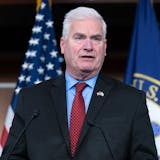Today, dirt fills the abandoned St. Paul swimming pool where two boys were injured on Memorial Day after they got around a fence and fell into several feet of murky water. The unused pool on the city's East Side is no longer a threat to public safety.
But the regulatory policy void that the accident revealed still demands action. Just after the boys were hurt, city and state officials found that neither government body had rules governing unused pools. The Minnesota Department of Health inspects and issues licenses for pools in St. Paul since it took over the function from the city in 2013. But state rules only apply to licensed, functioning pools.
One of the boys was treated and released, but the second remained hospitalized last week.
The absence of clear oversight responsibility for unused pools must change. Both state and city officials say they are working together on a solution. In a letter to the City Council, Ricardo Cervantes, St. Paul's safety and inspections director, wrote: "This situation clearly reveals a gap in who regulates unused pools. … City ordinances give us no direction and in the absence of coverage from the state … we will take action to clarify the city's [role] in picking up where the state leaves off in an ordinance change by the fall …''
That's good, but before fall comes summer. St. Paul and other jurisdictions without direction on unused pools should take stock of the potential hazards.
Though they had no statutory direction, St. Paul officials stepped up after the Memorial Day incident and wisely required the East Side property owner to take action under its public nuisance/public safety rules. Fortunately, the owner compiled and that particular pool is now history.
But as the swimming season is just beginning, St. Paul and other Minnesota communities with similar policy gaps need to know how many unused pools there are. And they need to take steps to be sure that they are properly secured. Better yet, if they are permanently closed, old pools should be removed altogether.
As St. Paul and the state work on regulatory language, they might look to other jurisdictions for guidance. Hennepin County for example, under its Ordinance 25, says that any "unsecured hole or opening'' constitutes a public safety threat and is prohibited.


